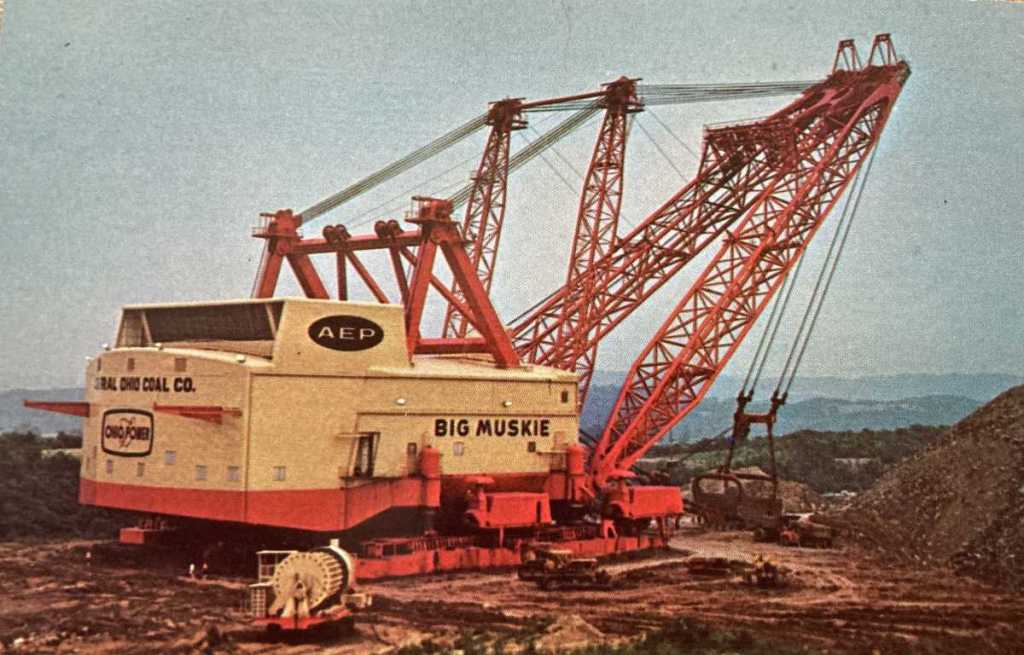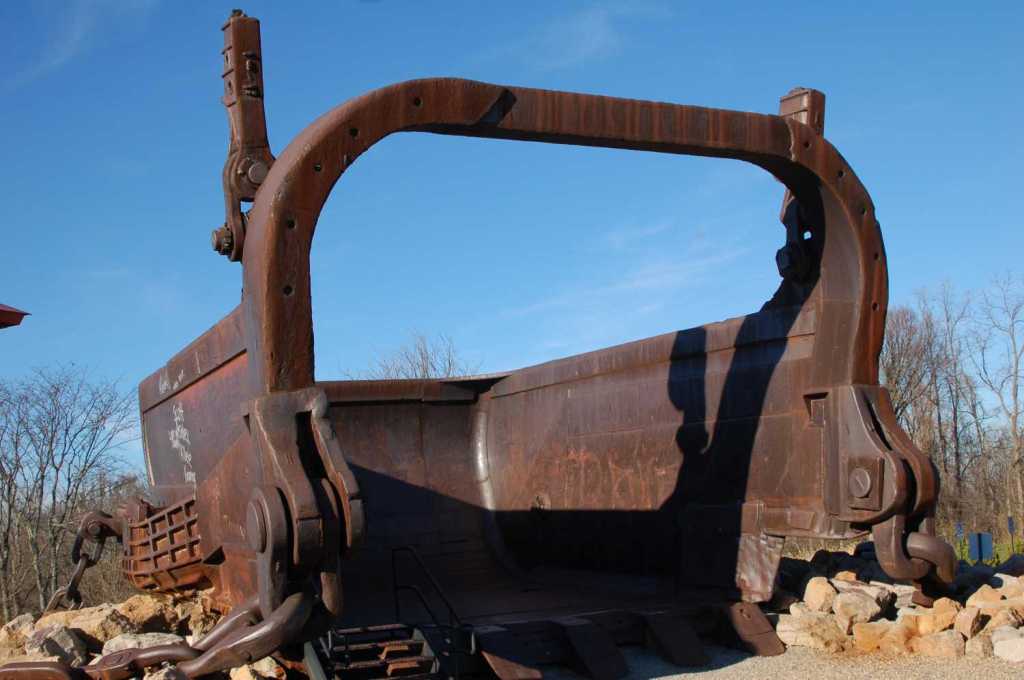
Postcard view of Big Muskie during its operational life from 1969 to 1991.
By Ken Drenten
I will admit this up front — as a former American Electric Power employee, I’m biased when it comes to energy sources for electricity. To me, it just makes sense to use a balance of resources for energy — including plentiful and powerful natural resources like coal, oil and natural gas. I would rather do this than limit ourselves to methods that seem cleaner but that also use up vast tracts of land, harm the environment and wildlife habitat, are less reliable and are much more expensive than others. But we’re now in the third decade of the 21st century and that debate has been largely settled.
The purpose of this post is to shine a little light on Big Muskie, the largest dragline ever built. All that remains today of Big Muskie is its 220-cubic-yard, 240-ton bucket, located at Miner’s Memorial Park near McConnelsville. And that is a very sizable chunk of metal.
From the late 1990s through the early 2000s, I had the good fortune to visit Central Ohio Coal Company several times as part of my communications work for AEP and to observe the surface mine and its amazing employees in action. By that time, other draglines and earth-moving equipment had taken over the job of Big Muskie, which had been retired, but was still intact. At that time, it could be seen standing tall and silent from miles away.
According to the Ohio Department of Natural Resources, Big Muskie was built on site due to its massive size. Starting in 1967, more than 300 railcars and 250 trucks hauled the necessary pieces to Muskingum Mine. It took a team of engineers and workers more than two years to erect Big Muskie. When completed, the massive machine stood 240 feet tall.
The behemoth digger worked by dragging its bucket along the ground to strip away layers of soil and rock that covered the coal seam. Big Muskie could lift 325 tons of earth and rock in a single “bite.” Between 1969 and 1991, Big Muskie ran 24 hours a day, 364 days a year with a regular crew of five.
In its working lifetime, Big Muskie moved more than 608 million cubic yards of rock and earth — twice the amount moved during construction of the Panama Canal. The machine uncovered more than 20 million tons of Ohio coal.

Big Muskie stood 240 feet tall. (Postcard photo)
Here are some of Big Muskie’s specifications:
- Model: 4250-W Bucyrus-Erie.
- Weight: 13,500 tons (27 million pounds).
- Boom length: 310 feet.
- Length of machine with boom down: 487 feet, 6 inches.
- Width: 151 feet, 6 inches.
- Cable diameter: 5 inches.
- Electrically powered: 13,800 volts.
- Mobility: Hydraulically driven walking feet.

Big Muskie’s bucket is the highlight of Miner’s Memorial Park. (Credit: Ken Drenten)
By the early 1990s, demand for high sulfur coal had declined significantly, and the cost to operate Big Muskie had increased. It was no longer economical to power and maintain Big Muskie, and operations ceased. There were efforts to have Big Muskie preserved and relocated, but these efforts were unsuccessful. In May 1999, Big Muskie was disassembled and scrapped. All that remains is the bucket.
Today visitors can walk up to and climb inside the bucket and imagine what it took to make such an enormous thing move. Miners Memorial Park is located at Jesse Owens State Park, 4470 SR 78, McConnelsville.
The Wall of Honor is another highlight of the park area, recognizing past employees of Central Ohio Coal Company, the AEP company that operated the Big Muskie. I consider these people to be part of the Greatest Generation. They knew how to work together, adapt and improvise to overcome tough situations, and get the job done. In addition to the memorial features found in this part of the park, visitors can enjoy a picnic area with a shelter, restrooms and a scenic overlook of the area.
Just a few miles away is The Wilds, made up of almost 10,000 acres of reclaimed surface-mined land. The land was donated by American Electric Power and opened to the public in 1994. The Wilds is home to to rhinos, giraffes, cheetahs, and other rare and endangered animals and serves as a living laboratory for international and local conservation scientists, with strong emphasis on restoration and wildlife ecology.
(Sources: Ohio Department of Natural Resources, The Wilds)
Subscribe to Dusty Tires and receive a weekly email with the latest blog article. It’s free and ad-free!
Ken Drenten is creator and manager of Dusty-Tires.com, a travel blog for out-of-the-ordinary places in Ohio.
All rights reserved, Dusty Tires (dusty-tires.com), 2024.
Leave a comment